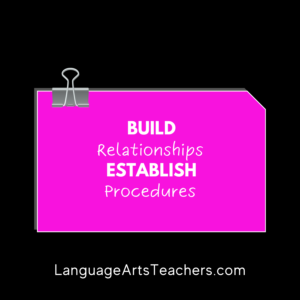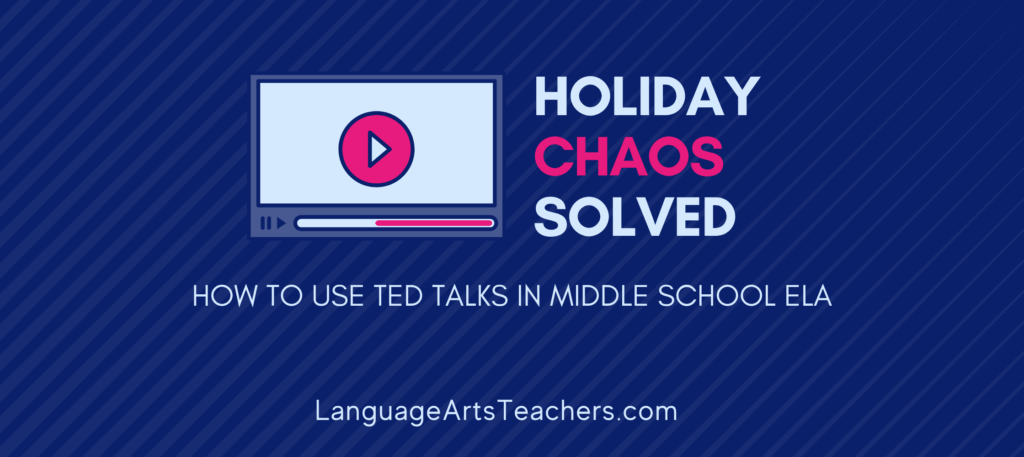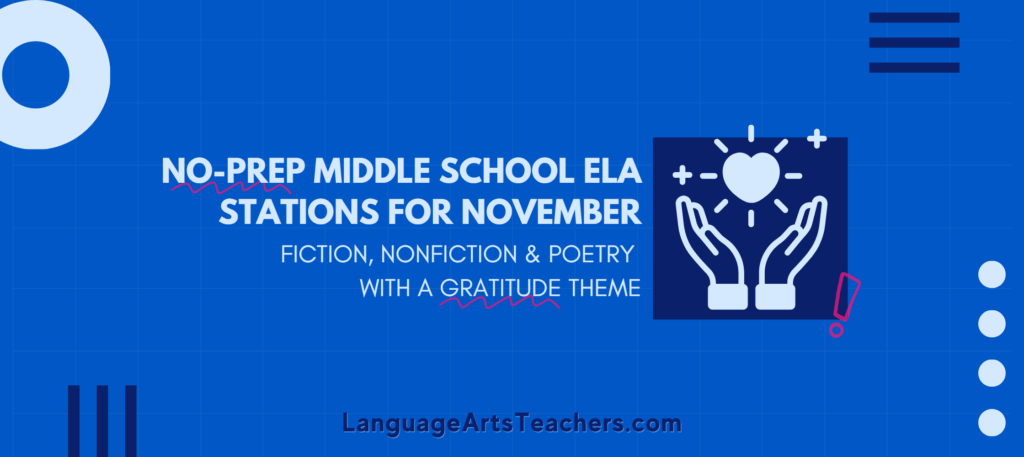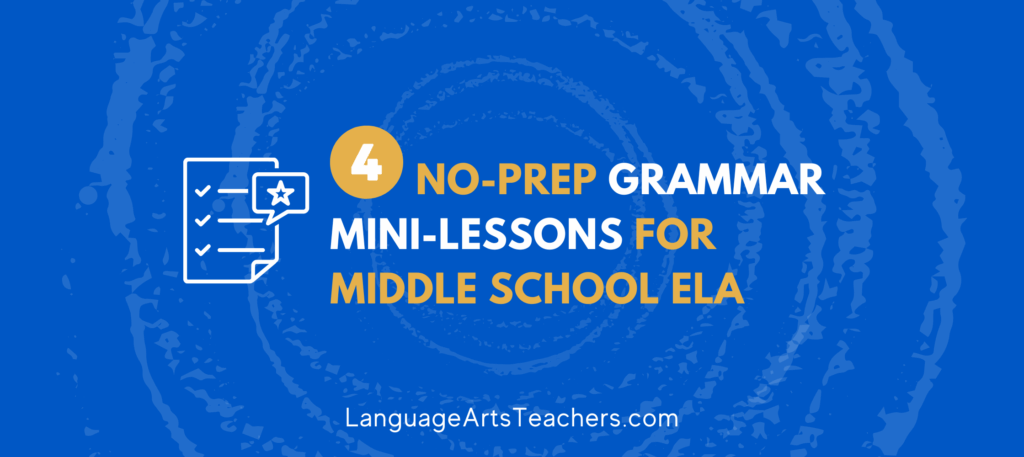In order to create a peaceful learning environment, it’s important for us as teachers to build positive relationships with their students. Establishing procedures and routines in the classroom can also help create a sense of predictability and security for students.
The tips, tricks, and timeliness of this topic is merely a snapshot of what we covered during an entire DAY of topics at the MSELA Summit >> The Virtual Conference for Middle School ELA Teachers I host each year. For all the days’ topics, themes, and sessions, head over to www.mselasummit.com.
But for this article, I’m going to share some practical ways to build relationships and establish procedures to create that peaceful, meaningful haven you’ve always wanted your Middle School ELA classroom to have!

Encouraging your students to engage
In order to encourage students to engage, educators can create an environment that is conducive to participation. This may involve establishing ground rules for respectful discussion, providing opportunities for students to share their ideas, etc.
Additionally, educators can ask questions that prompt critical thinking and substantive responses. For example, instead of asking “Did you like the book?” a teacher could ask “What were your thoughts about the protagonist’s motivations?” Do your best not to ask “yes” or “no” questions to keep the conversation rolling.
By taking these steps, educators can create an atmosphere in which students are more likely to engage with the material and with each other.
Expectations may vary between students
As a teacher, it is important to recognize that not every student is the same. Each student learns differently and at their own pace. As a result, expectations must be adjusted accordingly. While it is important to hold every student accountable for their work, it is also necessary to understand each student’s individual capabilities.
This way, you can ensure that every student is able to reach their full potential. By adapting your expectations to meet the needs of each individual student, you can create a learning environment that is optimal for everyone involved.
Create a personal connection
It can be difficult to establish personal connections with each individual student in a large classroom, but it’s important to try. A personal connection doesn’t have to be anything big or time-consuming – simply taking the time to learn each student’s name and something about them can make a world of difference.
When students feel like they are known and valued, they are more likely to be engaged in their learning and to take pride in their work. There are many ways to get to know your students – start by asking them about their interests during group work or taking a few minutes to chat with them before or after class.
By making an effort to connect with your students on a personal level, you’ll create a more supportive and successful learning environment for everyone.
Help new students hit the ground running
When a new student joins your class partway through the year, it can be tricky for them to catch up. They may have missed out on key concepts, or simply need some extra time to adjust to the class material.
As a teacher, you can play a vital role in helping new students hit the ground running. By providing a summary of what has been taught so far, or offering a short project that covers the essential information, you can help new students catch up to their classmates.
In addition, remember to be patient and flexible – new students may need some extra time to adjust to your teaching style and settle into the class routine.
By providing support and guidance, you can help ensure that every student has a chance to succeed.
Activities to use with your students to help them engage
There are a number of different things that you can do to help your students better engage, but here are a couple of ideas that may work for you.
The first is a responsibility on your end of better understanding what it means when a student answers with “I don’t know.” This is a typical answer from students, but should be one that you do your best to eliminate in your classroom
The better you can understand what the student actually means when they say this, the easier it will be for you to hold them accountable. Here are three examples of what “I don’t know” actually means when a student says it.
- The student doesn’t actually know
- The student is too shy to answer
- The student doesn’t feel like putting the effort into answering
To help combat the “I don’t know” issue in your class, you can come up with alternative sayings. This will help students to stay engaged and learn how to work through a problem even when they don’t know something.
Here is something that you might want to try. Create a class project with your students and have them come up with alternatives to saying “I don’t know.” With these different alternatives, you can make a poster and hang it in your classroom.
After that, when students are wanting to say “I don’t know,” you can have them select a different phrase from the poster to keep the conversation going.
Examples of “I don’t know” replacement sayings:
- Can I ask a friend?
- May I take a minute?
- Can you repeat the question?
- Can I get more information?
This will help to breed better conversation in your classroom and remove the “I don’t know” copout. Before you know it, your classroom will be filled with students that are better able to express themselves, and ultimately learning more.
Establishing procedures before class starts
A great way to help students get on track for class is to have a slide or two running as they enter into your classroom. It could be whatever you want on the slide, but you want something that makes your students smile and that will help them get settled into the mindset of learning and knowing what is expected of them for the day.
Here are a few examples and ideas:
- Funny GIF (animals with expressions work well)
- What we’re doing today (simple agenda)
- Emotional check-ins with Peardeck or humorous images
- Questions for reflection: How can you help yourself today? What can you do to move forward?
Teaching students how to self-manage
Another critical key of classroom procedure is teaching students how to self-manage. As a teacher, if you are having to manage every little situation for every student, your job will be very tedious. This will limit your ability to teach, and will lead to burnout.
On the flip side, if you can teach a student how to better self manage themself, you can free yourself up to teach the classroom as a whole. And also, this just better teaches students how to become more successful at life and dealing with small issues that pop up from time to time.
When you don’t have good classroom management
When students act out in class, it is often a sign that they don’t have good classroom management. This can be overwhelming for students, as they may feel unsure how or what to prioritize.
Additionally, anxiety about what to do next can lead to students feeling lost and confused. As a result, acting out in class is often a way for students to express their frustration at not knowing how to handle the situation.
Acting out can look like:
- shutting down
- disengaging
- disrupting
- deciding to do something off task altogether
To help prevent this from happening, it is important for teachers to have a good system of classroom management in place. This should include clear expectations for students, as well as a system for dealing with disruptions in the classroom.
By having a well-organized classroom, teachers can help reduce the amount of stress and anxiety that students feel, and prevent acting out from occurring.
Building relationships in summary
Really this whole article has been about building relationships with your students in one way or another, but just to speak specifically on building relationships, there are a few things to consider.
First, make sure that you are showing each student respect and engaging with them. You expect the same from your student to you, so do your best to show the proper example, even with the difficult students.
Secondly, be consistent with your rulings, interactions, etc. As a human, you will have some days that are better than others, but do your best to make sure that you are showing consistency with your students no matter how your day is personally going.
Finally, be able to adjust and pivot when needed, and then when you do happen to make a mistake, apologize to the student or students involved, and move on. This will show your students that it is okay to mess up, but that when you do, you need to own up to it and make things right.
Classroom Procedures and Relationships Conclusion
Building relationships and establishing procedures in your classroom can be a daunting task, but it is so important for the success of your students.
By following the tips and tricks laid out here, you should be well on your way to having a great year with your students! If you need a LOT more in terms of classroom management, lesson planning, and reading & writing strategies for Middle School ELA, then check out all the topics and sessions from the MSELA Summit so we can help you!




